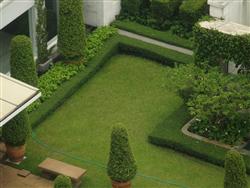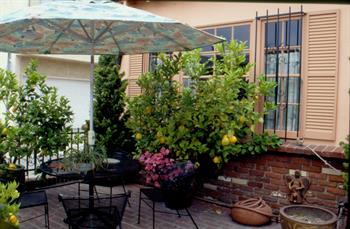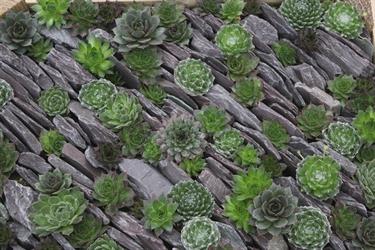Courtyard Gardens
Small spaces can be a puzzling challenge for Australian gardeners, used to quarter acre blocks. They needn't be. Some of the most stunning gardens I've ever seen are areas no more than a few metres wide, which with good design and a little imagination, have been turned into the envy of all who visit.
 What Is A Courtyard Garden?
What Is A Courtyard Garden?
A court or courtyard garden is a garden space that is enclosed by walls or buildings on three or four sides, or a confined yard that is generally surrounded by houses, and with an opening off a street. Courtyards can be as small as a few square metres, such as the space between a house and garage, or between a house and a side fence. They can also be quite large, such as those found surrounded by large city buildings, or surrounded by classrooms and walkways in a school. Courtyard gardens are common in inner city areas, where homes are generally packed close together, and with limited garden space, such as terrace houses.
Courtyards are usually open to the sky, but can also be partially covered, such as by a pergola, or completely covered by transparent coverings, such as glass, or polycarbonate. Some houses are designed to have a courtyard enclosed or surrounded by the house, enabling it to be seen from different angles, and so that it appears to be part of the house. Courtyards are an ideal use of a small space that may not be big enough for use as a work or living area - simply turn the area into a decorative feature. Larger courtyards may have areas of lawn, but smaller ones are generally unsuitable for lawns, with paving, and mulched areas being more common.
Characteristics Of Courtyard Gardens
The protected nature of courtyards, provided by the surrounding fences or walls has both advantages and disadvantages. Courtyards provide protection from climate extremes, particularly wind, from excessive noise or bad views. They can also be very private. Protection from strong winds may lead to poor ventilation - this can be a problem for some plants, particularly those that are subject to attack by fungal diseases. Large areas of paved surfaces and concrete or brick walls may lead to heat build up in the garden. This can be an advantage in cooler months, but can be a real problem in warmer times. Reflected heat and glare can also be a problem damaging tender plants, or making the area too glary to use on bright days. Poor light can also be a problem if the the courtyard is surrounded on one or more sides by tall buildings, or overhanging trees that block out the light for part, or even all of the day.
Water and Drainage
The protected nature of courtyards, especially if they are partially or completely covered, means that plants in the garden may not get sufficient natural rainfall, particularly those plants that are close to walls or fences. Supplementary watering is normally essential. For small courtyards hand watering with a hose or watering can may be sufficient, but for those with larger courtyards, and those who don't want to spend a lot of time watering, then installing a watering system is the answer. Water can also be made a feature of courtyard gardens, through the use of small ponds, birdbaths, or even small fountains. The water evaporating from these will help create a humid environment that will benefit some types of plants (e.g. ferns).
Drainage can be a major problem in courtyard gardens, particularly if you have water features in the garden. There is usually a high percentage of paved areas, as well as enclosing structures (e.g. fences & walls), and no natural surface drainage (slope). Provision of good drainage is therefore essential.
 Some Design Ideas
Some Design Ideas
- The type of paving material chosen will have a major effect on the overall appearance of the courtyard. Glazed pavers and concrete slabs can create a formal effect, while bricks and stone will often give a softer, more informal look. Pavers can be chosen to match tiles, other surfacings, used within the house, so that courtyard blends into the house.
- Spaces or gaps can be left in paved areas to create planting spaces.
- A feeling of space can be created by the use of painted landscape or garden scenes on walls.
- The feeling of space can be further expanded by having the garden merge into the house. Glassed entry areas and the use of indoor plants can help achieve this.
- Lighting can be installed enabling you to use the courtyard at night, and to highlight particular plants or features. Any cables should be hidden from plain view as much as possible, but be careful that they are not placed in a position where anyone is likely to dig.
- Removable shadecloth panels can be used over parts of a courtyard to provide summer shade.
- Secateurs are an important tool for maintaining courtyard gardens. One or two plants let lose can quickly outgrow the available space.
- "Stepped" or irregular shaped walls, as well as irregular shaped garden beds, can be used to reduce the 'box-like' effect that can be associated courtyards surrounded by straight fences or walls.
- Keep the design simple by avoiding the temptation of using too many different types of materials or plants. If you use a lot of different colours and textures, the space can seem more confused and appear smaller.
- Avoid active colours (eg. red, yellow and orange) as these make small spaces seem smaller.
- Use colours such as blues, whites, greens and purples to make small spaces seem larger.

Planting Ideas For Courtyards
Careful plant selection can make the most of the limited space, and reduce the impact of problems such as glare and heat build up. Consider the following:
- Shade trees (deciduous) can be used to provide summer shade and winter light. It is important to choose species that will not have too invasive a root system, or will grow to big for the size of the garden.
- Do not over plant your garden. Remember that plants can grow very quickly once established, and you may find you have no space left to move in yourself.
- For courtyards that receive limited sunlight use shade-loving plants, such as ferns, begonias, fuchsias, impatiens and balsam.
- Containers are a good idea as they can be moved. This will enable you to create changing vistas within the courtyard. Also plants in flower, such as annuals, can be moved to prominent positions, while plants (e.g. roses, hydrangeas) that may not look so good at particular times of the year can be hidden in less prominent positions. Camellias, dwarf rhododendrons and azaleas make excellent tub plants for cooler sites, while palms, dracaenas and crotons, are good for warmer areas.
- Hanging baskets are an excellent way to make more use of available space, and will make the appearance of the garden more interesting, offering something to see at different eye levels.
- Espaliered plants and vines require very little ground space, and are good for small courtyards. They can be used to cover walls helping to merge them into the garden, and reducing glare and heat build up. Espaliered fruit trees can be both an attractive addition to the garden as well as providing fruit. Vines can be grown on pergolas to provide partial cover over the courtyard, or can be grown on trellis or wire framework to extend the height of surrounding walls to provide extra privacy or shade. Be careful to avoid creepers with invasive roots (e.g. English Ivy) that may damage fences or walls.
- Dwarf trees can create the image of a much larger garden. There is a huge range of dwarf conifers that would be suitable. Dwarf fruits, such as some of the citrus or dwarf apples, such as the 'Ballerina' range, are not only attractive, but make excellent plants for containers or small beds, as well as providing excellent tasting fruit.
- For long, narrow courtyards, such as entry areas, ground cover and low growing plants can be grown to spill over paved walkways to soften the long straight lines of the pathway, to reduce the visual effect of distance. Statues or other features can also be placed at either end of the courtyard to create a focal point which also reduces the visual effect of distance.

Knowing the Plants is Critical!
It's not uncommon for home owners to spend several weeks wages, fixing a problem that could have been avoided, if they had chosen the right plant, and avoided using plants that create problems.
- Plants can do more damage, and cause more problems in a confined space like a courtyard
- You can either become an expert with plants yourself (a better long term solution), or hire an expert.
- You can't always depend on the advice of someone claiming to be an "expert"; unless they have excellent plant knowledge.
- If a consultant, nurseryman or garden designer can talk confidently, using scientific names for hundreds of different plants; they are going to give better advice than the "expert" who only talks about a small number of different plants
- The advice of an expert is only really valuable if they know your property well; so go to nurserymen who live and work on similar soils, in your locality. Use garden designers who are familiar with your area.
- The wrong tree can cause very serious structural damage to a house, paving, walls, ponds etc.
- Even shrubs and climbers can cause structural problems
- Some plants will bring pests to your house -ants, termites, mice, rats, cockroaches, etc
Learning to Identify Plants can be Easier, once you get over the initial hump.

There is a system to plant identification. When you learn that system, it becomes easier to remember names, pronounce names and understand how different plants will perform.
Two ways to learn plant names:
Option 1. Study our Horticulture II course -This is longer; taking 100 hrs to complete; but it is more thorough. If you plan to work in horticulture this is really a "minimum".
Option 2. Plant Identification Video/CD package.... We have packaged together a series of videos, produced here at ACS, that teach you the system; and how to identify around 600 different plants. It takes 3.5 hours (approximately) to watch these. You should watch them several times and make notes as you go, if you want to get over that initial hump and make plant identification easier for yourself. This is a unique series; used by this school for years. It works! -available through our bookshop www.acsbookshop.com
Want to Know More?
Consider doing a course or buying a reference book from our school.
If you would like to communicate with one of our professional tutors, consider using our free course counselling service. click for details
If you want to browse our bookshop, go to www.acsbookshop.com
More from ACS
Ebook - 102 great pages and pictures, informative: types of climbers; positioning; supports; encyclopaedia.
View eBook
Ebook - Inspiring: covers formal, natural, eclectic, modern, oriental, Mediterranean; zoom in on stunning images and plans.
View eBook
Ebook - A must read for the enthusiast and amateur: 124 pages of bursting colour, covers care as well as identification.
View eBook
Ebook - Shade types, creating shade, designs, shade plants, water, culture, propagation.
View eBook
Course - draw designs, survey sites, understand plants, soils, timbers, climate, and other landscape materials pivotal to the success of a good landscape design.
View Course
Course - Popular design certificate that has launched many enthusiastic and talented design students into the industry.
View Course